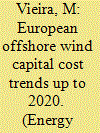|
|
|
Sort Order |
|
|
|
Items / Page
|
|
|
|
|
|
|
| Srl | Item |
| 1 |
ID:
166557


|
|
|
|
|
| Summary/Abstract |
Offshore wind capacity has increased significantly over the past decade with 16 GW installed by the end of 2017. Offshore wind technologies present an effective tool for EU countries to address their renewable production targets, as extensive areas of high winds are available offshore. However, offshore wind is not yet cost competitive in European electricity markets, and frequently requires support schemes to finance extensive capital cost requirements. Therefore, capital cost reductions are critical to make offshore wind technologies competitive in the market. Here, a benchmark tool to analyze capital expenditure trends associated with offshore wind implementation in Europe up to 2020 is provided. A database of all existing farms was developed, detailing more than 21 GW of already commissioned or consented capacity, and trends were described using multiple linear regression models. Results indicate that following a consistent rise from 2000 to 2015, capital costs have since begun to decline. The impact of several farm parameters such as turbine capacity, average farm depth or farm location on the capital expenditures have been estimated.
|
|
|
|
|
|
|
|
|
|
|
|
|
|
|
|
| 2 |
ID:
111455


|
|
|
|
|
| Publication |
2012.
|
| Summary/Abstract |
On a $/kW basis, wind turbine prices in the U.S. have declined by nearly one-third on average since 2008, after having previously doubled over the period from 2002 through 2008. These two substantial and opposing trends over the past decade - and particularly the earlier price doubling - run counter to the smooth, gradually declining cost trajectories predicted by standard learning curve theory. Taking a bottom-up approach, we examine seven possible drivers of wind turbine prices in the U.S., with the goal of estimating the degree to which each contributed to the doubling in turbine prices from 2002 through 2008, as well as the subsequent decline in prices through 2010. In aggregate, these seven drivers - which include changes in labor costs, warranty provisions, manufacturer profitability, turbine scaling, raw materials prices, energy prices, and foreign exchange rates - explain from 70% to 90% (depending on the year) of empirically observed wind turbine price movements in the U.S. through 2010. Turbine scaling is found to have been the largest single contributor to the price doubling through 2008, although the incremental cost of scaling has been justified by greater energy capture, resulting in a lower cost of wind generation.
|
|
|
|
|
|
|
|
|
|
|
|
|
|
|
|
| 3 |
ID:
111456


|
|
|
|
|
| Publication |
2012.
|
| Summary/Abstract |
On a $/kW basis, wind turbine prices in the U.S. have declined by nearly one-third on average since 2008, after having previously doubled over the period from 2002 through 2008. These two substantial and opposing trends over the past decade - and particularly the earlier price doubling - run counter to the smooth, gradually declining cost trajectories predicted by standard learning curve theory. Taking a bottom-up approach, we examine seven possible drivers of wind turbine prices in the U.S., with the goal of estimating the degree to which each contributed to the doubling in turbine prices from 2002 through 2008, as well as the subsequent decline in prices through 2010. In aggregate, these seven drivers - which include changes in labor costs, warranty provisions, manufacturer profitability, turbine scaling, raw materials prices, energy prices, and foreign exchange rates - explain from 70% to 90% (depending on the year) of empirically observed wind turbine price movements in the U.S. through 2010. Turbine scaling is found to have been the largest single contributor to the price doubling through 2008, although the incremental cost of scaling has been justified by greater energy capture, resulting in a lower cost of wind generation.
|
|
|
|
|
|
|
|
|
|
|
|
|
|
|
|
|
|
|
|
|